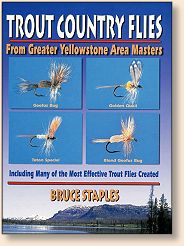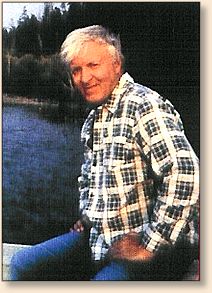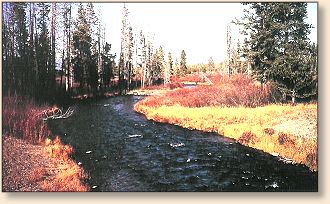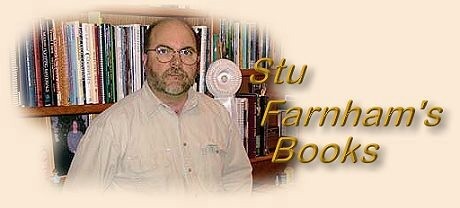|
The Internet is a powerful resource. It provides us instant
access to information, and brings us together via email,
bulletin boards, chat rooms, and instant messaging. FAOL
is a wonderful example of the Internet at its best. The Internet,
however, will never replace the printed page.
I've loved books and fishing since my youngest years, although
I did not start fly fishing until 1993. This column will give
me an opportunity to share reviews of some of my favorite fly
fishing and tying books (and some that are not such favorites)
with my friends here at FAOL. My library reflects my tastes
and interests, and so will this column. It will be heavily
slanted towards cold water fishing and tying for trout and
steelhead, and won't touch much on areas of which I know little,
such as warm or salt water fishing.
I hope that these reviews will motivate some of you to pick up
a good book, on this or any subject, and read.
~ Stu Farnham
Trout Country Flies
 Trout Country Flies
Trout Country Flies
by Bruce Staples
Spiral-bound or soft cover: 167 pages
Publisher: Frank Amato Publications, Inc.; (January 1, 2003)
ISBN: 1571882480
Ho-hum, you're probably thinking, another
trout fly pattern book.
Well, yes, but. . .
I thoroughly enjoyed Bruce Staples' Trout Country Flies
from Greater Yellowstone Area Masters. Sure, the format
has become pretty much standard over the last few years: over
500 fly pattern recipes beneath Jim Schollmeyer's photographs,
several to a page. Certainly, a lot of these flies are equally
familiar: serendipities and sofa pillows, sparkle duns and
sparkle pupae.
There are many things that make this more than a pattern book.
To begin with, the patterns Staples has chosen range in time
from the 1920s wet fly aptly named the Yellowstone to
contemporary flies such as Phil Blomquist's Pink Sparkle
Emerger, developed in the 1990s. For another, he draws on
the creativity of the legendary fly tier's from the
intersection of Idaho, Montana, and Wyoming: Jack Dennis,
Bud Lilly, Bob Jacklin, Craig Matthews, Gary LaFontaine,
Rene Harrop, and others.
 A sense of history pervades the book, which opens with a
reproduction of a fishing guide to the West Yellowstone/Island
Park area printed by Don Martinez in the early 1940s. The
introduction takes us through the history of fly fishing
in the area, starting with the period of early (non-native)
exploration in the latter half of the 19th century. By the
beginning of the 20th century, wealthy families from the
East established sporting retreats in the Island Park area.
The contributions of George Grant (best known for his
woven-body nymphs), the Wombacher family, Don Martinez,
Dan Bailey, and others are noted.
A sense of history pervades the book, which opens with a
reproduction of a fishing guide to the West Yellowstone/Island
Park area printed by Don Martinez in the early 1940s. The
introduction takes us through the history of fly fishing
in the area, starting with the period of early (non-native)
exploration in the latter half of the 19th century. By the
beginning of the 20th century, wealthy families from the
East established sporting retreats in the Island Park area.
The contributions of George Grant (best known for his
woven-body nymphs), the Wombacher family, Don Martinez,
Dan Bailey, and others are noted.
In the chapter on caddis adults we find Mike Lawson's
spent partridge caddis and Bob Jacklin's Fluttering Gray
Caddis. Caddis pupas include Syl Nemes' Mothers Day Caddis,
a favorite of mine for the Brachycentrus hatches occurring
throughout the West form March through May. There's a chapter
of crane fly patterns, and one of damsel- and dragonflies.
Dry fly attractors include the familiar (Humpies and Goofus
Bugs) and the outlandish (Chuck Echer's BLT Cutthroat, a
takeoff on the Chernobyl ant patterned after a sandwich).
Among the mayfly duns are Don Martinez's Golden Quail (see
the cover illustration) and Bing Lempke's famous extended
body, loop wing duns.
Other chapters cover mayfly nymphs and spinners, still-water
and leech patterns, stonefly adults and nymphs, streamers,
terrestrials, wet flies, and attractors. Numerous examples
of the woven body flies most closely associated with George
Grant and Franz Potts appear throughout.

The annotations accompanying each pattern credit the originator
(if known) and provide some of the history of the pattern.
The final chapter of the book presents short profiles of
several legendary fly tiers from the Yellowstone area: Pat
Barnes, Charlie Brooks, Bob Carmichael, Henry's Fork legend
Bing Lempke, Don Martinez (whose influence, along with that
of George Grant, is felt throughout the book), and Stan
Yamamura.
My only complaint with the book is that it lacks an index.
(Publisher's Note: This may be an anomaly with the spiral-bound
book, we have the soft cover and it has both an index and fly index.)
Others have mentioned to me problems with color reproduction in
their copies; however, the colors in mine appear true.
~ Stu Farnham
About Stu
 Stu Farnham is a New Englander by birth, who was transplanted to
and put down roots in Oregon in the early 1990s, now residing in
the Seattle area. A software engineering manager by vocation,
he can be found in his spare time chasing trout and steelhead
in the rivers of the Pacific Northwest, chasing his four Gordon
Setters (who in turn are chasing chukar), tying flies, reading,
or working on his website. Colleen, his long suffering wife of
28 years, is a professionally trained personal chef.
Stu Farnham is a New Englander by birth, who was transplanted to
and put down roots in Oregon in the early 1990s, now residing in
the Seattle area. A software engineering manager by vocation,
he can be found in his spare time chasing trout and steelhead
in the rivers of the Pacific Northwest, chasing his four Gordon
Setters (who in turn are chasing chukar), tying flies, reading,
or working on his website. Colleen, his long suffering wife of
28 years, is a professionally trained personal chef.
|

 Trout Country Flies
Trout Country Flies
 Stu Farnham is a New Englander by birth, who was transplanted to
and put down roots in Oregon in the early 1990s, now residing in
the Seattle area. A software engineering manager by vocation,
he can be found in his spare time chasing trout and steelhead
in the rivers of the Pacific Northwest, chasing his four Gordon
Setters (who in turn are chasing chukar), tying flies, reading,
or working on his website. Colleen, his long suffering wife of
28 years, is a professionally trained personal chef.
Stu Farnham is a New Englander by birth, who was transplanted to
and put down roots in Oregon in the early 1990s, now residing in
the Seattle area. A software engineering manager by vocation,
he can be found in his spare time chasing trout and steelhead
in the rivers of the Pacific Northwest, chasing his four Gordon
Setters (who in turn are chasing chukar), tying flies, reading,
or working on his website. Colleen, his long suffering wife of
28 years, is a professionally trained personal chef.
 A sense of history pervades the book, which opens with a
reproduction of a fishing guide to the West Yellowstone/Island
Park area printed by Don Martinez in the early 1940s. The
introduction takes us through the history of fly fishing
in the area, starting with the period of early (non-native)
exploration in the latter half of the 19th century. By the
beginning of the 20th century, wealthy families from the
East established sporting retreats in the Island Park area.
The contributions of George Grant (best known for his
woven-body nymphs), the Wombacher family, Don Martinez,
Dan Bailey, and others are noted.
A sense of history pervades the book, which opens with a
reproduction of a fishing guide to the West Yellowstone/Island
Park area printed by Don Martinez in the early 1940s. The
introduction takes us through the history of fly fishing
in the area, starting with the period of early (non-native)
exploration in the latter half of the 19th century. By the
beginning of the 20th century, wealthy families from the
East established sporting retreats in the Island Park area.
The contributions of George Grant (best known for his
woven-body nymphs), the Wombacher family, Don Martinez,
Dan Bailey, and others are noted.